Cinders Postmortem #1: The Game Itself
It’s almost exactly half a year since Cinders‘ launch. Six months is ample time for anything that could happen to happen. What was to be achieved, is achieved. What didn’t work out can’t be fixed anymore. In other words — with no surprises ahead — it’s a good moment to look back at the game and write a proper postmortem.
There’s a lot to talk about, so I’ve decided to break it into three articles:
- The Game: This one. A critical look at Cinders from the artistic and game design point of view. A sort of review of our own game.
- Business and Production: business aspects, production issues, and how we handled promotion. Yes, that includes sales numbers.
- Indie Life: A look back at how our full-time indie lifestyle has worked out. Changes in everyday lifestyle are why many devs decide for or against going indie, so I thought it’s as worth talking about as sales and game development issues are.
I also want to break from the usual form of writing postmortems. I find the standard “what worked / what didn’t” convention to be rather limiting. Some things are simply too hard to classify as straight failures or successes. Instead, I decided to dedicate a paragraph to everything I think is worth mentioning.
Choices:
This is where it all started. Even before we knew what our game was going to be about, Gracjana had had this idea of making a fairytale adaptation, where you can really affect the outcome in significant ways. To us, most indie VNs feature far too little player agency and are often unclear about what the consequences of your decisions are. We considered it a core responsibility of Cinders to have a lot of decision points that allow the player to shape both the story and the protagonist’s personality, as well as plenty enough endings to make all these choices worthwhile. Basically, we wanted to follow what I wrote in my blog post about what I consider interesting game choices.
This is an aspect of Cinders that we’re happy about the most. The game has 120 decisions points with over 300 options to pick, and there are no meaningless ones. High amount of choices and dialogue options makes it feel more like an RPG or an adventure game at times, which is something we aimed for.
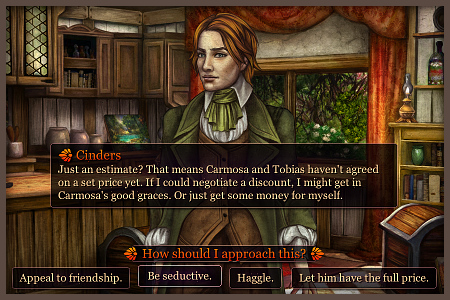
Of course, some players like more kinetic stories with less choice buttons to click, but most were happy with what they can do in Cinders, pointing the amount of possible routes as its high point. The branch icon, that appears whenever current events are an outcome of some earlier choice, was also welcomed by the players. We’ll definitely use this feature in our upcoming games.
Presentation:
High quality presentation is another aspect that we considered to be crucial. We wanted to give indie VNs a push into a more professional direction. These days, when even cheap casual games look absolutely stunning by default, we thought that for the $20 the average VN costs, players are entitled to something not giving the vibe of being amateur work.
We feel that we mostly succeeded with this. Gracjana’s art and Rob’s music was almost universally praised in reviews, and they were what got many people interested in the game in the first place. What surprised us, though, is the reaction of the core anime VN audience. We were afraid that we’re going to alienate them by going for a different look, and it was something that other VN developers warned us about. But in the end, anime VN fans seemed the most open to trying something else. Actually, I don’t think we ever got a negative comment from anybody from the core VN audience.
On the other hand, Cinders’ presentation was not enough to break through to the more mainstream audience, which is something we silently hoped for. It may be simply that VNs are bound to remain a niche genre, but we still want to try to improve this aspect in Solstice and see if it changes anything.

We think that Cinders looks rather nice, but it’s still a bit too static, especially compared to games such as Ace Attorney. We use many character poses and emotional expressions, but we’ve made one mistake here. Instead of focusing on having a large number of possible combinations, we should make sure that they are all distinctive at the first glance. There’s also a lot that could be done with the way the text appears, to make it better resemble the way people actually talk. We took some cues from japanese games here, but we could do better (and plan to in Solstice).
Some fellow AAA game developers also pointed out that Cinders could use more sounds. It’s something that went mostly unnoticed by our players, as most VNs are rather minimalistic in that regard, but they had a point. For example, it really wouldn’t kill us if we added some fireplace cracking and birds singing ambience in the Cinders’ room. It’s little work and such details matter if you want to catch attention of players used to the incredible quality of modern games.
By the way, if you want to know more about the process of making art for Cinders, you can check this series of articles on our artist’s blog.
The Message:
The game’s themes and message are the third aspect of it that we considered to be a key element. Since the very start, it was supposed to be a more serious re-telling of Cinderella with strong feminist overtones. A story about growing up and ditching the naive fairytale worldview, where everyone is either good or evil, fate rules, and everyone gets what they deserved.
We’ve got mixed feelings about how this part went. We succeeded on some basic level — players noticed the themes and liked them. We got some really touching emails from people who found resemblances of their own problems in the game and thanked us for talking about it. And that’s always a great feeling for the creator. It’s also largely why we were able to get the game covered in media that don’t usually review VNs — like Kotaku, TheMarySue, or Polygon. “A feminist retelling of Cinderella” simply raises eyebrows, and — if it’s done well enough — gets you some brownie points with the press. Among countless indie games released each month, it’s good to talk about something interesting enough to make a story.
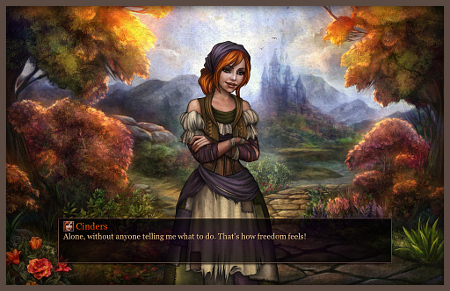
Thing is, while we didn’t botch it or anything, we think we were a bit too heavy-handed at times. As one player pointed out, Cinders has its heart in the right place, but sometimes sounds like a self-help book. Characters have a tendency to wax philosophical and drop golden thoughts on every opportunity, and it can get pretty cheesy. It may be partially because for the last few years we were working on casual games, where everything has to be said loud and clear to be noticed. We also may have underestimated our audience a bit.
This is a mistake we definitely want to correct in our future games. We really adore the idea of entertainment with a message. Games and stories that are fun but can also work on a deeper level and carry some meaning. However, we think it works best when the audience is allowed to draw their own conclusions, without the characters bashing your head with: “Look here! A message.”
The Plot:
The plot is central to any VN. That’s a no-brainer. It was the first time I had to develop and handle a branching storyline of this size. While it did cause some production problems I’m going to talk about in the next article, I’m mostly happy with the outcome. The story makes sense, lacks any major plot holes, there’s a lot branching and it doesn’t break anything. It starts a bit too slow and is too wordy at times, but I think it’s within acceptable range. Especially for something that’s more of a character study than an epic action adventure. Our writing will definitely refine in time, so I’m not too concerned about small mistakes here and there.
There are some problems though, that I would like to avoid in our future games. Not all of them matter from the player’s perspective, but they certainly do from mine.
First of all, we have too many plot points and devices. For example, if Cinders is interested in re-taking her residence, there’s the missing last will, the faked ball invitations, the family’s money problems, and the poisoning option. We could cut one or two of those subplots out, and the game would still have a plenty of meaningful choice. At the same time, it would allow us to dedicate more time to the remaining subplots and develop them better. Choosing to poison the Stepmother or investigating the last will could be nice full stories of their own. As it is, they are squeezed between all the other options. Same applies to romances. Too many of them, too little space to develop them fully.
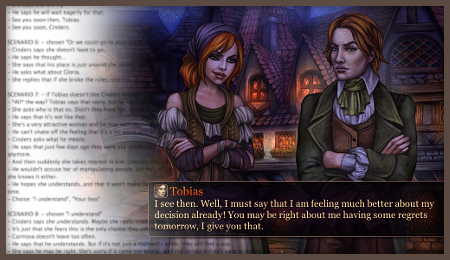
Another thing I would like to change in our future games is going for a slightly more directed story. Cinders allows for a lot of freedom. Throughout most of the game, the player is in almost full control of what happens. You can go somewhere, or go somewhere else, or do things in a different order, or not do them at all. It’s a logical consequence of our philosophy of allowing for a choice whenever something important happens and one could act in several ways. In theory, that’s good. The problem is that it can make the story pretty chaotic in structure, depending on what the player does.
For instance, early in the game, Cinders notices her stepmother had a mysterious nightly visitor. She can then decide to follow him into the woods to see what he’s up to, or stay at home. It’s a reasonable choice at that point and it tells us something about Cinders’ personality. Thing is, the story gets an interesting hook in place only if she decides to go. There’s a mystery to solve, and certain character’s surprising involvement may be a crucial plot point in some routes. Otherwise, it’s just life as usual for a while longer, which makes perfect sense, but doesn’t work that well storytelling-wise.
We still would like to make our stories as flexible as possible. It’s definitely a strong point of Cinders. But at the same time, it’s better to make sure that the player can’t miss some crucial elements and plot points. It makes it easier to tell an engaging story with a clear hook, a buildup, and some grand finale. Player choices should focus on subplots, route picking, and role playing.
The Characters:
The characters of Cinders are pretty easy for me to assess. Women are good, guys could be better. The game obviously focuses on the Stepsisters and the Stepmother, and their personalities are the most developed and complex. I know people with similar experiences and issues in real life, which helped a lot in making their problems and motivations feel believable and morally ambiguous. I think this worked rather well. All women at the house can be really awful to each other, but it becomes understandable if you decide to get to know them better. I think this is what actually gives the game a valid message, not the somewhat heavy-handed mottos that we slipped here and there.
Male characters, on the other hand, are just okay. I honestly thought they are going to come out worse, but I’m still not entirely happy with them. I know that Perrault has some pretty strong following in the fandom, but we honestly could do much better. I feel that we’ve managed to avoid cliches with our females, and gave each one a complex and believable personality. Guys, however, fall into the trap of being the somewhat standard “ideal lover” tropes. There’s the rough-on-the-outside-but-soft-in-the-heart knight, the distant and mysterious prince, and the funny and understanding childhood friend. They could start a boys band.
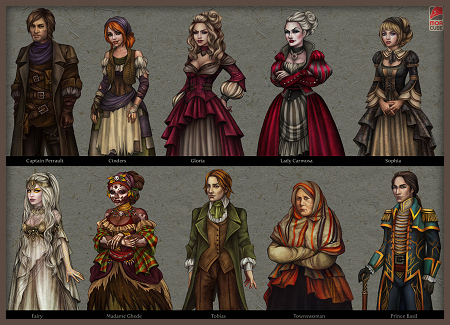
As romance is not the focus of the game, the guys don’t get enough screen time to develop them properly and make their affection towards Cinders believable. It works with Tobias, as they have some history together, but I really had to twist my head to figure out how to make the grumpy captain of the guard fall for a young girl so hard, he’s willing to escape the town with her. And after just a few meetings! It works in the end, but just barely, and it’s a bit too fairytale-ish, undermining the themes of the game.
The Prince gets the worst of it. There was supposed to be a parallel between him and Cinders, with them both living in a shadow of a charismatic parent and being somewhat lonely despite their privileged conditions, but there’s simply not enough time in the game to pull that off. It’s rather lengthy as it is. I see it as a wasted opportunity.
Again, cutting down the amount of subplots could allow us to flesh out these characters better. Live and learn.
Cinders’ Personality:
This is a very interesting aspect. The most polarized feedback we’ve got was regarding Cinders’ personality. Most praised her for being active, witty, and knowing what she wants. But then there were voices that she’s too passive, conservative, and naive. Or that she doesn’t have any personality at all. So, the exact opposite. Doesn’t compute.
We see two possible explanations for this. First of all, we may have given too much freedom in this regard. When faced with the option of being nice and altruistic or more selfish and mean, many players will pick the first choice, even if they want to play a more edgy character. Then, they are surprised that the game starts assuming that they are playing the naive and overly selfless Cinders.
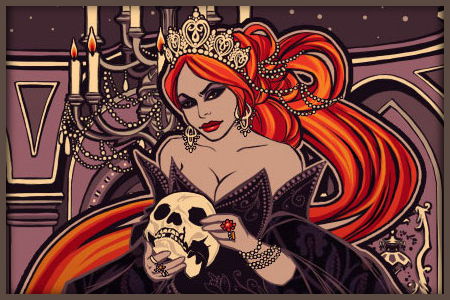
Second explanation is that the game takes some time to collect player’s decisions and extrapolate the protagonist’s personality based on them. Cinders is sort of a blank slate throughout the first half of the game. Not until the second half we have enough data to really guess what she wants and how she’d behave in any given situation. That may be a bit too long.
A solution to both these issues is, just like with the subplots and characters, more author control. The protagonist should always have a distinctive and interesting personality, and the player picks which aspects of it are dominating. In this case, Cinders would always be witty and a bit self-centered (we all love flaws, don’t we), but if the player picks the goodie-goodie options all the time, she realizes that sometimes you have to put the needs of the others before your own (after some struggle and funny comments). It would work better that way, and we want to try it out in Solstice.
Reception and Our Own Assessment:
Cinders was received well. The press liked it, the visual novel community liked it, players liked it. It even got an award for the second best interactive fiction of 2012 on GameZebo, and the best on Indie Statik, as well as made numerous smaller lists of favorite indie VNs. It also spawned a small fandom on tumblr. Which may mean that we are over-estimating the value of the mistakes pointed out in the earlier paragraphs.
Of course, even despite the okay coverage and appearing in places such as Rock Paper Shotgun or Kotaku, the game didn’t really get through to the mainstream audience or gain virality on par with the more prominent indie hits. Still, for a new indie studio releasing its first game, and a niche VN of all things, we believe we have no rights to complain.
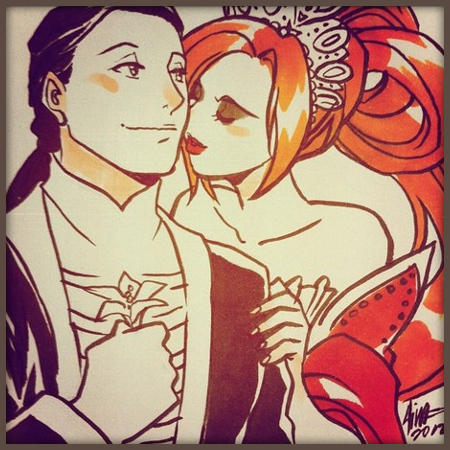
This fanart by Irma “Aimo” Ahmed still amazes me.
If you are wondering if I’m personally happy with Cinders, I would say that, yeah, I’m rather happy with it. It’s not perfect, and I see some flaws I would really like to iron out in our future releases, but it mostly lived up to our own expectations. It’s a cool feeling. Usually we’re very critical towards our own games, maybe even overly so. This is the second one after Phantasmat we’re actually pretty proud of. Still, there’s definitely room for improvement, and I hope that we’ll manage to avoid all these (often rather basic) mistakes in our future releases.
Stay tuned for part two, where I’ll talk about the business aspects of Cinders, our marketing effort, and the mistakes we did regarding the production.
Ren wrote a comment on: January 14, 2013 at 11:53 pm
I really liked this, it feels honest and not self-complacent.
I also was really interested in the bit where you talk about Cinders’ personality and how it would be a good idea not to make her a blank slate, but rather to give her a base and make her go in one or other direction more depending on the choices. That’s actually the kind of approach that I’d like the most as I don’t like completely empty characters, but I want some freedom, too. But what I like is to interfere, not to go completely astray… I’m not sure if I can convey this well.
I was actually a bit put off by what I saw of the male characters and much more intrigued by the sisters and the mother (even more than Cinders) from what I’ve seen of them in the demo so I agree with that point too.
Given the amount of self-awareness in this post, I’m definitely even more interested in Solstice. 😀
And yes, please: put more sound effects! They make everything feel so alive! The sound is one of the thing that struck me in the Solstice video, I’m really anticipating that title!
TeeGee wrote a comment on: January 15, 2013 at 1:07 am
Thanks. It wouldn’t make much sense as a postmortem if it was self-complacent :). The whole idea is to get some distance and take a critical look at your own work, so you and others can learn from your mistakes.
Anna wrote a comment on: January 17, 2013 at 5:43 pm
I don’t know if I’ve said this before, but Cinders is the only game I’ve played that actively encourages me to turn it off. 😀
Me: I wanna game another hour, it’s not that late!
Cinders: Show some responsibility!
Me: But… I don’t want to.
Cinders: Your fate is up to you! Every choice matters!
Me: You’re right, Cinders. It’s a school night, I need to sleep.
I actually think this is kind of cool. 🙂
Ervin Bishop wrote a comment on: January 25, 2013 at 1:26 am
I’ve played some of the recommendations on this page. I really like playing games from a female perspective, as long as there’s some multiple demographic appeal. If it’s just pure romance it’s pretty boring to me but if it includes some mystery, fantasy, sci-fi, or action elements I find I actually prefer a female protagonist. I’ve read some free otome games from the Lemma Soft forums (Requiem of the Abyss, Frozen Essence, etc) and they were fun, but I really wish I could read something similar only with higher production values but I haven’t really seen anything like that. Tokemeki Memorial/Starry Sky both seem like they’re very heavily romance oriented which isn’t something I’d read.
Booyah wrote a comment on: January 28, 2013 at 12:52 am
Very much looking forward to part 2 of this!
Fhoenix wrote a comment on: February 2, 2013 at 11:26 am
Just finished playing Cinders for the first time. And I must say, the game is incredible. It can be cheesy yes, but it has such a strong message. In the end I came from it with the feeling of “I can take my life into my own hands. I can change the world!” It was very positive and uplifting.
And your family. Oh, your family. Sophia and Gloria were my favourite characters in the game. It was interesting, changing my perspective from hating them in the beginning, to coming to understand them, to rooting for them in the end. Sophia, especially, I just loved. Even though she hated me till the end 😀 (must have been some flag I set wrongly)
p.s. Why is forum registration blocked? I wanted to write a bigger impressions with spoilers and stuff there. I am kinda bursting at the seams now 🙂
p.p.s. You make a very good review of your own work, noting both the strong and the weak points. But let me strongly disagree with one thing. “it’s better to make sure that the player can’t miss some crucial elements and plot points” It sounds reasonable, yes. But you know, that decision to follow or not follow the night visitor was important to me. I agonised, and in the end I followed him, yes. And the game came better for me. But because the decision was there, I felt like the result was one, that came of my own actions. If the game just fed me plot points, it would not really have the same feel. I got one of the best endings, and it felt great, because I saw, how my actions have led there. But if anything, I say, getting it was a little bit too easy. Even with all the supposed branches, I had two godmothers ready to do my bidding AND support from Tobias AND some juicy blackmail material (which the game would not allow me to use, because I was so awesome, I did not need it) And that’s on my first try! I would maybe like the game to make me work a little more for the best outcome. Even though, as I said, making (almost) everything work out in the end for Cinders felt great.
Fhoenix wrote a comment on: February 2, 2013 at 11:52 am
Oh look how many “in the end” I used. That was horrible, if I say so myself.
One more thing. From what I remember, the press coverage was weak. The only reason I knew about the game, was because I was still waiting for the Archmagi. And even for me it took this long to actually get around to playing it. I don’t remember anything on Kotaku, and RPS just made a very small news about the game. It’s the damn genre’s fault of course, almost nobody takes VN seriously. But definitely not enough good big reviews. I myself need to read quite a lot more then four paragraphs, to actually make me play a VN on the spot. Not because I dislike them, on the contrary. It’s just hard to get into a new VN, takes energy to start, and you really need somebody passionate to push you in the right direction.
TeeGee wrote a comment on: February 2, 2013 at 5:15 pm
Thanks! Glad you liked the game so much :).
I think the coverage was surprisingly good for a VN. Most don’t even get a mention from the mainstream press. But for a ‘normal’ game? Yeah, it’s hard to break through with a VN and get any mainstream websites to review it (or even look at it). We’ve got a nice review on IndieGames, GameZebo, and The Mary Sue, as well as some mentions in a few “Best of 2012” lists, but nothing too big. I’ll write about it in more detail in the second part.
Thanks for your input on the choice to follow the Shady Character. I’ll definitely keep it in mind.
Forums are currently closed because some bug allows spambots to run rampage despite our security measures. We’ll fix it before Bonfire release and re-open registrations. Sorry for that. If you have feedback, you can always post it in the comments (don’t worry about spoilers, it’s a postmortem article anyway) or just fire me an email :).
CS wrote a comment on: February 2, 2013 at 5:34 pm
Can’t wait for the rest of the post mortem when you decide to pull yourself away from Ni No Kuni.
Cairy wrote a comment on: February 10, 2013 at 3:03 pm
When a person makes something (a game, a book), often I saw a a distinct lack of auto-criticism, which is understable. That said, congratulations for your level of self-awareness. You were able to recognize the flaws as well the merits and it’s not a small thing.
As regards the game, I liked it very much. The few flaws that I saw (the male characters, the dialogues) have already been extensively explored. A thing that I really liked it’s that some secondary characters seems to be much more than they appear, though I would have liked to know more about them. In the story there are numerous points that are very misteryous and that are not quite cleared in the ending(s). For one the backstory of The Fairy and Cinder’s mother. Maybe some things have to remain unknown.
TeeGee wrote a comment on: February 11, 2013 at 2:52 am
Thanks. Yes, a lot of that ambiguity is intended. I don’t think it’s good to explain everything to the last detail, especially if it involves some mystical beings like the fairies. It would kinda kill the charm of the mystery. I think it’s better to leave some things to interpretation, perhaps with a little hint here and there.
Heart wrote a comment on: February 14, 2013 at 5:07 am
When are you gonna post part 2? D:
TeeGee wrote a comment on: February 14, 2013 at 10:18 am
Working on it. Should be out soon. It got delayed because first Ni No Kuni decided to take hold of my free time, and then I got sick ;).
Rifty wrote a comment on: February 23, 2013 at 2:28 pm
Just saw this linked to tumblr, and I do have to agree that the guys didn’t get enough time to shine, especially the poor prince. His endings always seemed a bit too fairy tale, though with the slight oh well this is old times we gotta get married in this weird fashion otherwise it’s arraigned marriages for everyone! Or at least that’s the feeling I got from it.
As for too many options when it came to how to resolve the issue, whether through blackmail, poison, or the old will, it kinda seemed natural and I at least didn’t think that it was too much all over the place, especially since I didn’t start getting multiple options until after my first couple playthroughs so it almost seemed like say the will was the option you got from romancing perrault, but the fake letters were from tobias, I realize it was happenstance that it worked that way for me but until I found that out I thought it was neat that the different routes could offer different solutions.
As for the chosing to go after the shady guy or not, it was nice to have what felt like a significant choice so early in, in my first playthrough I didn’t follow him, and while that cost me interesting story things, well you can’t make it too easy on us and hold our hands the whole way. This is a game as well as a story so you gotta have some way to challenge us and make us replay and learn.
I never really found cinders to be too much of a blank slate, but then I guess I generally was picking the witty dialogue bits so she always seemed spunky, it almost seemed more like she was tired in the begining and was only later waking up and energizing herself to finally go after her goal.
As for the game being rather right there about it’s morals for this game it did seem to fit that it was more blatant with them since it is based on a fairytale and well fairytales always have been the means of conveying morals.
Ps, can we have a boyband with the three love interests now? That would be amusing.